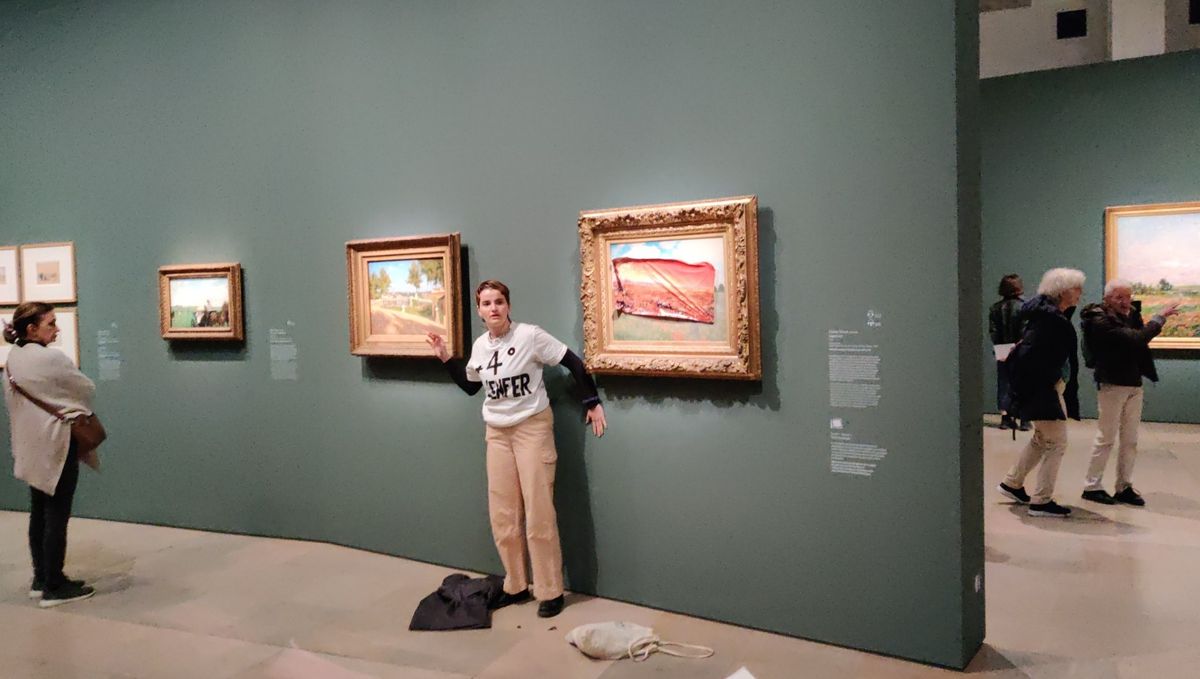One of Claude Monet’s most recognisable paintings, Coquelicots (Poppies) (1873), was defaced by a climate activist from the Riposte Alimentaire group on 1 June. Wearing a white t-shirt with the words “+4°[C] L’Enfer” [“+4°[C] Hell”] on it, the protestor entered the gallery where the glazed painting is on show—in Paris’s Musée d’Orsay—and affixed a poster depicting a scorched scene blighted by the effects of climate change. Monet’s painting, drawn from the museum’s permanent collection, is currently featured in the exhibition Paris 1874: Inventing Impressionism (until 14 July).
The action prompted an angry response from the French culture minister, Rachida Dati, who said on X (formerly Twitter): “This destruction of art by delinquents cannot be justified in any way. It must stop! I contacted the [justice ministry], for the implementation of a penal policy for this new form of delinquency which attacks the most noble aspect of our cohesion: culture!” France’s ministry of culture did not respond to a request for comment.
In a post on X, Riposte Alimentaire said that “a citizen involved with the Food Response campaign covered the [Monet] painting… with a nightmarish version of the same painting, representing a field of poppies in 2100.” It is unclear if the activist has been charged.
“This is what Claude Monet would probably have painted in 2100 if no radical measures are taken to stop climate change by then,” the group added on social media. “As a reminder, this IPCC [Intergovernmental Panel on Climate Change] scenario is not the most pessimistic, since a trajectory of more than +4°C is projected.”
A spokesperson for the Musée d'Orsay say that it has lodged a complaint. "After examination and treatment by a restorer, the work was rehung on Saturday [1 June] and the exhibition was able to reopen. The activist was arrested and kept in police custody until yesterday, when she was temporary released; she’ll be judged by the court on 2 July."
Last month activists from Riposte Alimentaire scattered orange powder around the Galerie des Glaces at the Palace of Versailles outside Paris. The protestors said in an Instagram post: “Through this action, Riposte Alimentaire wishes to raise awareness about growing inequalities, allowing a privileged minority to monopolise part of the resources, while the majority of citizens collect the crumbs.”
Meanwhile authorities in France have charged the Luxembourg-born artist Deborah De Robertis with “damage to cultural assets” following a protest at the Centre Pompidou-Metz last month when two women daubed the words “Me Too” on L’Origine du monde (The Origin of the World, 1866)—an explicit full-frontal female nude by the French painter Gustave Courbet. An embroidered work by the French artist Annette Messager, I Think Therefore I Suck (1991), was also removed from the exhibition.
De Robertis confirmed the charges in an Instagram post, saying that “the police summoned her on 29 May [regarding charges for] robbery and damage… this is not theft but an artistic gesture.”
De Robertis posted a video on Vimeo entitled On ne sépare pas la femme de l’artiste (“the woman cannot be separated from the artist”)—showing the protest. In an accompanying statement, she said she wanted to highlight the “misogynistic divide” in the art world.


